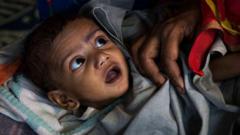The missing puzzle piece in understanding child stunting in India is the critical role played by caste discrimination, according to a recent study by Ashwini Deshpande of Ashoka University and Rajesh Ramachandran from Monash University, Malaysia. While official data shows that 35% of India's 137 million children under five are stunted—a figure higher than the average of 33.6% in Sub-Saharan Africa—the factors influencing these statistics extend beyond mere height comparisons.
Stunting, defined as being below the expected height for age, is a significant indicator of malnutrition and is particularly troubling given that India and Sub-Saharan Africa encompass 44% of the global population under five yet account for about 70% of stunted children. The study argues that issues of caste-based social identity have been largely overlooked in discussions about child nutrition, affecting access to healthcare and nutrition, particularly in the first 1,000 days of a child's life.
For context, this “golden period” is vital as 80% of the brain's development occurs by the age of two, establishing the foundation for a child's lifelong potential. Amidst significant progress in both regions, India's stunting rate remains a grim indicator of socio-economic disparities. The economists conducted a comparison based on official data demonstrating that children's stunting rates varied dramatically across caste lines in India.
Notably, children from higher-ranked caste groups experienced a stunting rate of 27%, which stands in stark contrast to the rates in marginalized communities such as the adivasis and Dalits, who make up more than a third of India’s under-five population. The findings show that children from marginalized backgrounds are approximately 20% more vulnerable to stunting than their counterparts from advantaged groups.
Despite years of affirmative action aimed at improving the living conditions of lower-caste populations, entrenched caste hierarchies continue to severely limit the caloric intake and general health environment available to many families. Various competing hypotheses have emerged over the years regarding the root causes of child stunting, spanning from genetic predispositions to poor nutrition and broader socio-economic issues.
Nevertheless, the study underscores that it is not merely economic status but the intersection of caste, educational attainment, and maternal health that exacerbates vulnerabilities among the poorest households in India. The analysis draws on demographic health surveys from 2019-21 for India and a broader range of data from Sub-Saharan Africa, encompassing over 400,000 children under five.
In conclusion, while improvements in health and nutrition interventions are having a positive impact, it is crucial to address the underlying social identity issues linked to caste in order to combat the child stunting crisis effectively and ensure equity in child health outcomes across India.
Stunting, defined as being below the expected height for age, is a significant indicator of malnutrition and is particularly troubling given that India and Sub-Saharan Africa encompass 44% of the global population under five yet account for about 70% of stunted children. The study argues that issues of caste-based social identity have been largely overlooked in discussions about child nutrition, affecting access to healthcare and nutrition, particularly in the first 1,000 days of a child's life.
For context, this “golden period” is vital as 80% of the brain's development occurs by the age of two, establishing the foundation for a child's lifelong potential. Amidst significant progress in both regions, India's stunting rate remains a grim indicator of socio-economic disparities. The economists conducted a comparison based on official data demonstrating that children's stunting rates varied dramatically across caste lines in India.
Notably, children from higher-ranked caste groups experienced a stunting rate of 27%, which stands in stark contrast to the rates in marginalized communities such as the adivasis and Dalits, who make up more than a third of India’s under-five population. The findings show that children from marginalized backgrounds are approximately 20% more vulnerable to stunting than their counterparts from advantaged groups.
Despite years of affirmative action aimed at improving the living conditions of lower-caste populations, entrenched caste hierarchies continue to severely limit the caloric intake and general health environment available to many families. Various competing hypotheses have emerged over the years regarding the root causes of child stunting, spanning from genetic predispositions to poor nutrition and broader socio-economic issues.
Nevertheless, the study underscores that it is not merely economic status but the intersection of caste, educational attainment, and maternal health that exacerbates vulnerabilities among the poorest households in India. The analysis draws on demographic health surveys from 2019-21 for India and a broader range of data from Sub-Saharan Africa, encompassing over 400,000 children under five.
In conclusion, while improvements in health and nutrition interventions are having a positive impact, it is crucial to address the underlying social identity issues linked to caste in order to combat the child stunting crisis effectively and ensure equity in child health outcomes across India.


















